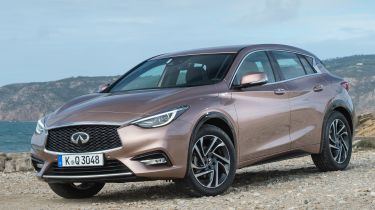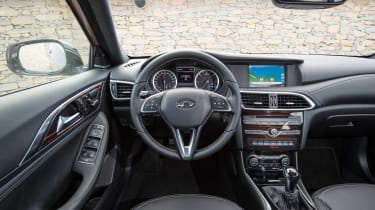Infiniti Q30 review - Interior, design and technology
There is an air of luxury to the Q30. Most materials feel good, but fit and finish could be better

The Q30 is clearly part of the Infiniti family and shares the curves of its relatives - but in a much more accentuated way. The curved grille and sweeping lights are also familiar. There are some questionable bits of trim around the boot opening but on the whole it appears to be very well built.
There is also the option of the Sport trim. This lowers the car by 15mm and the bulkier bumpers and black details add to the overall sportier look, even if it's subtle. The Sport model also sits on 19-inch wheels rather than the standard 18s, while Infiniti offers different wheel options, including rims with a purple pinstripe finish.
On the inside the Infiniti is well appointed and feels plush. Comfort is the key word here: You get the sense that Infiniti has built this car as a mile muncher, someone spending a lot of time in the driver’s seat would appreciate the pleasant materials and air of 'premium'. For example, the seats have been designed with the aim of supporting your upper and lower back to relieve pressure by not straining one particular part.
In terms of solidity and quality, however, it's a mixed bag. You'll find better fit-and-finish in German rivals, with certain areas feeling a bit flimsy and rattles on models we've tested.
On the technology front, the higher specification cars come with the option of sound cancelling speakers, to cut out some of the engine and road noise. When it comes to clever tech there isn’t anything particularly special on the Q30, however. The majority of electrical features you can see appear to be pinched from Mercedes, including the tablet-style infotainment screen and control wheel on the centre console. Automatic models show off their Mercedes roots further by having that firm's traditional column-mounted gear selector.
Sat-nav, stereo and infotainment
Infiniti's optional InTouch infotainment system is reasonably easy to use. The control interface is the same as the A-Class, and combines a touchscreen with a wheel and a selection of buttons on the centre console. This does make it easy to navigate using one or both ways of controlling the system, though there's no source or track skip buttons on the wheel. The mapping display looks very similar to the Mercedes COMAND system, too, but brighter colours do make it easier to read.









